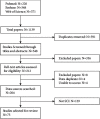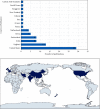A Review on Characteristics of Experimental Research on Acupuncture Treatment for Alzheimer's Disease: Study Design
- PMID: 35855822
- PMCID: PMC9288276
- DOI: 10.1155/2022/8243704
A Review on Characteristics of Experimental Research on Acupuncture Treatment for Alzheimer's Disease: Study Design
Abstract
Background: This review aims to systematically summarize and analyze recent high-quality animal research results about the use of acupuncture in Alzheimer's disease (AD) patients. This information will be useful in providing a reference for future experimental research and an experimental basis for the clinical use of acupuncture in the treatment of AD.
Methods: We utilized and referenced various electronic libraries from their inception to November 2021. Relevant information was reviewed and information such as the journal names, publication records, animal model selections and preparations, intervention measures, acupoint selections, detection methods, and detection indicators was extracted. Results. A total of 75 eligible studies were selected for additional review. Male SAMP8 mice, APP/PS1 double transgenic mice, Sprague-Dawley (SD) rats, and Wistar rats were the four commonly used animal strains in the experiments. The animals were categorized as transgenic and surgical mouse models. Experimental interventions included manual acupuncture (MA), Electro-acupuncture (EA), Moxibustion, and EA combined with Moxibustion. A retention time of 20 min was the optimal timing for experimental studies, with 14 sessions chosen as the most common treatment time. EA was the most prescribed acupuncture treatment type with continuous wave, 2 Hz frequency, and 1 mA electric current selected as frequently used parameters. A total of 78 acupoint prescriptions were analyzed involving 21 acupoints. The top 3 combinations of common acupoints were GV20 ⟶ EX-HN3, GV20 ⟶ BL23, and GV20 ⟶ GV26. A total of 39 articles had positive drug control groups, sham acupuncture, and/or nonacupoint control groups. Furthermore, 10 types of behavioral tests, 29 detection methods, 178 evaluation indicators, and 18 tissue samples were included in the analysis.
Conclusions: By collating these high-quality research studies systematically and comprehensively, acupuncture was found to be a viable and effective treatment in AD animal models. In addition, when designing experiments, researchers could refer to the detailed data provided here to make better schemes and maybe conduct more investigations in unresearched areas.
Copyright © 2022 Chao Ke et al.
Conflict of interest statement
The authors declare no conflicts of interest.
Figures






Similar articles
-
[Effect of electroacupuncture of different acupoint groups on learning-memory ability and expression of IL-1β and TNF-α in hippocampus and prefrontal cortex in rats with Alzheimer's disease].Zhen Ci Yan Jiu. 2020 Aug 25;45(8):617-22. doi: 10.13702/j.1000-0607.190887. Zhen Ci Yan Jiu. 2020. PMID: 32869570 Chinese.
-
Behavioral Changes and Hippocampus Glucose Metabolism in APP/PS1 Transgenic Mice via Electro-acupuncture at Governor Vessel Acupoints.Front Aging Neurosci. 2017 Jan 24;9:5. doi: 10.3389/fnagi.2017.00005. eCollection 2017. Front Aging Neurosci. 2017. PMID: 28174534 Free PMC article.
-
Effects of manual acupuncture combined with donepezil in a mouse model of Alzheimer's disease.Acupunct Med. 2019 Feb;37(1):64-71. doi: 10.1136/acupmed-2016-011310. Epub 2019 Mar 7. Acupunct Med. 2019. PMID: 30843424
-
[Regularities of acupoint combinations and characteristics of core acupoint application for acupuncture-moxibustion treatment of mammary gland hyperplasia based on complex network analysis].Zhen Ci Yan Jiu. 2021 Jan 25;46(1):76-83. doi: 10.13702/j.1000-0607.200696. Zhen Ci Yan Jiu. 2021. PMID: 33559431 Review. Chinese.
-
[Complex network analysis on regularities of acupoint combinations and application characteristics of acupuncture and moxibustion in the treatment of knee osteoarthritis].Zhen Ci Yan Jiu. 2022 Jan 25;47(1):65-70. doi: 10.13702/j.1000-0607.20210080. Zhen Ci Yan Jiu. 2022. PMID: 35128873 Review. Chinese.
Cited by
-
Visualization of Microcirculation at Acupoints in vivo of Alzheimer's Disease Animal Model with Photoacoustic Microscope: A Pilot Study.J Alzheimers Dis Rep. 2024 Apr 8;8(1):561-574. doi: 10.3233/ADR-230193. eCollection 2024. J Alzheimers Dis Rep. 2024. PMID: 38746630 Free PMC article.
References
Publication types
LinkOut - more resources
Full Text Sources

